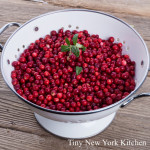Cranberries
These tart, bright ruby-red berries grow wild on evergreen shrubs in peaty marshland all over northern Europe and North America. They are closely related to blueberries and bilberries, but are much more sour and are always served cooked. They are closely related to cowberries and lingonberries.
Cranberries are sometimes known as bouceberries since they were traditionally tested for firmness by being bounced seven times. Any berries that failed the bounce test were too squashy and were, therefore, discarded. Because of their waxy skins, cranberries keep for much longer than other berries, which helps to explain their popularity.
Cranberries contain useful amounts of vitamins C and D, potassium and iron. They used to be considered to be good protection against scurvy, and they are known to contain a natural antibiotic. Cranberry juice has long been recommended as a natural remedy for cystitis, kidney, bladder and urinary tract infections.
Look for plump, firm, bright, red berries and check the base of the carton in case of squashed or shriveled berries. Fresh cranberries will keep in the refrigerator for four weeks, or freeze them in plastic bags.
Cranberries can be used in both sweet and savory dishes or can be juiced and served as a drink. Their most famous incarnation is as cranberry sauce. The berries are high in pectin, so they make excellent jams and jellies. They also combine well with orange and apple, and can be mixed with blackberries and raspberries for an autumn version of summer pudding. Cranberry sorbet is a delicious treat. When cooking them for a sweet dish, do not add the sugar until the skins have popped or they will become tough.
“Work With What You Got!”
© Victoria Hart Glavin Tiny New York Kitchen © 2016 All Rights Reserved






